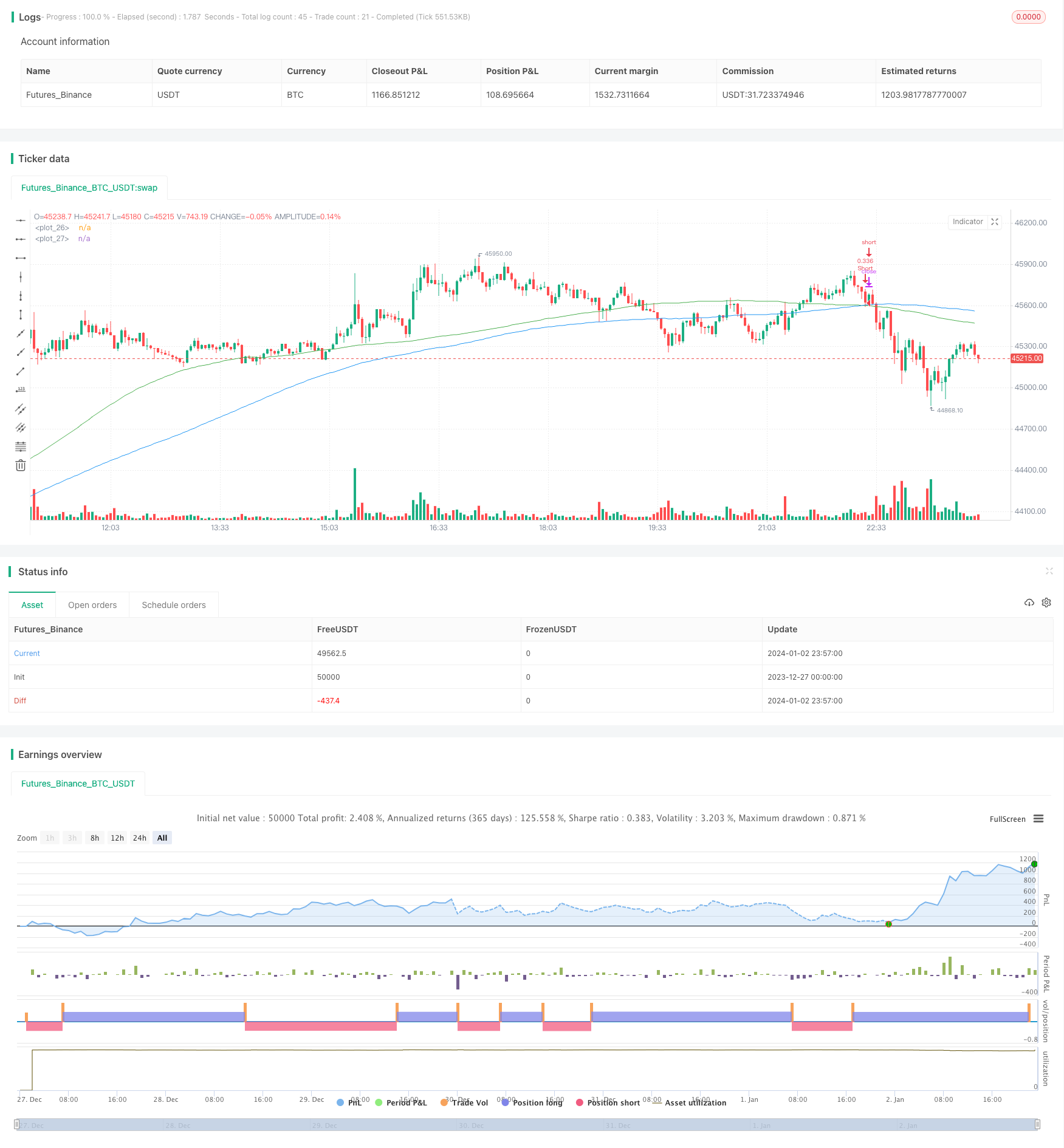
概述
本策略 named为“RSI和SMA金叉死叉策略”,其核心思想是利用RSI指标判断超买超卖,并结合SMA均线的金叉死叉形成交易信号。当RSI高于50并且短期SMA高于长期SMA时做多,当RSI低于50并且短期SMA低于长期SMA时做空。
策略原理
该策略主要利用了RSI指标和SMA均线的组合来形成交易信号。其中,RSI指标用于判断证券价格的超买超卖情况。RSI指数高于50表示为超买区,低于50表示为超卖区。SMA均线的金叉死叉也常用于判断买卖时机。本策略就是将RSI指标和SMA均线的交叉信号结合在一起,形成交易决策依据。
具体来说,当RSI指标高于50(超买区)并且短期SMA均线上穿长期SMA均线(金叉)时,则做多;当RSI指标低于50(超卖区)并且短期SMA均线下穿长期SMA均线(死叉)时,则做空。这样既利用了RSI判断超买超卖的功能,又利用了SMA均线的金叉死叉信号,两者结合可以提高决策的准确性。
策略优势分析
相比单一利用RSI指标或者SMA均线,本策略结合两者的优势有:
可以更准确判断价格的超买超卖情况。仅看SMA均线时,价格可能已经进入超买超卖区域;仅看RSI时,并不能完全判断价格走势的转折。两者结合可以形成比较完整的判断依据。
可以过滤掉部分噪音信号。仅凭SMA均线的金叉死叉可能会出现一些错误信号,而结合RSI指标可以过滤这些噪音。
可以把握趋势的更多机会。在行情出现明确趋势时,仅凭RSI可能会错过部分机会,而结合SMA均线则可以持续跟踪趋势参与更大行情。
总的来说,RSI和SMA的组合可以相互补充形成更为完整的交易决策依据,在捕捉趋势的同时也可以减少错误信号,从而可能获得更好的回测指标。
风险分析
本策略也存在一些潜在风险需要注意:
参数设置风险。RSI周期和SMA均线的长短需要设置得当,如果参数设置不当则会出现交易信号错乱的情况。
特殊行情风险。在某些特殊行情下指标可能会失效,如价格Limit Up/Down时、停牌复牌后的价格跳空等情况。这时交易信号可能会出现错误。
回撤风险。在行情出现较大回调时,策略账户也会产生一定回撤。可以通过加大头寸管理来控制这方面的最大损失。
实现难度风险。RSI和SMA均线相对简单,但要调整参数并达到实际盈利还需要一定的技巧与经验。
优化方向
本策略还可以从以下几个方面进行优化:
测试不同参数下的优化组合。可以尝试不同长度周期的RSI与SMA,找到最佳参数组合。
加入止损策略。如设立移动止损、缩量止损等方式来锁定盈利、控制风险。
结合其他指标过滤信号。如MACD、布林带等指标可用来辅助确认交易信号,减少错误。
不同品种参数差异化。部分品种参数设置可以进行差异化优化以获得最佳结果。
优化仓位管理策略。如iskycan等高级开仓方式,或设立波动率位置调整机制等。
总结
本策略通过结合RSI指标和SMA均线的交叉进行决策,既可以判断价格的超买超卖又可以抓住趋势机会。相比单一指标,具有判断更为准确、过滤噪音更出色的优点。同时也需要注意控制回撤、优化参数组合等风险,通过持续优化可以获得更好的策略效果。总的来说该策略简单实用,是量化交易的一个很典型的策略思路。
/*backtest
start: 2023-12-27 00:00:00
end: 2024-01-03 00:00:00
period: 3m
basePeriod: 1m
exchanges: [{"eid":"Futures_Binance","currency":"BTC_USDT"}]
*/
/// This source code is subject to the terms of the Mozilla Public License 2.0 at https://mozilla.org/MPL/2.0/
// © ExpertCryptoo1
//@version=5
strategy('RSI and SMA',
overlay=true,
initial_capital=1000,
process_orders_on_close=true,
default_qty_type=strategy.percent_of_equity,
default_qty_value=30,
commission_type=strategy.commission.percent,
commission_value=0.1)
showDate = input(defval=true, title='Show Date Range')
timePeriod = time >= timestamp(syminfo.timezone, 2022, 1, 1, 0, 0)
notInTrade = strategy.position_size <= 0
//==================================Buy Conditions============================================
//RSI
length = input(14)
rsi = ta.rsi(close, length)
//SMA
fastEMA = ta.sma(close, 100)
slowEMA = ta.sma(close, 150)
plot(fastEMA, color = color.green)
plot(slowEMA, color = color.blue)
bullish = ta.crossover(fastEMA, slowEMA) and rsi > 50
bearish = ta.crossover(slowEMA, fastEMA) and rsi < 50
strategy.entry("Long", strategy.long, when=bullish and timePeriod)
strategy.close("Exit", when=bearish)
strategy.entry("Short", strategy.short, when=bearish and timePeriod)
strategy.close("Exit", when=bullish)